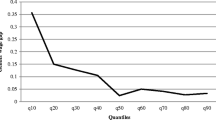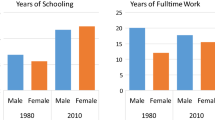Abstract
Mulligan and Rubinstein (2008) (MR) argued that changing selection of working females on unobservable characteristics, from negative in the 1970s to positive in the 1990s, accounted for nearly the entire closing of the gender wage gap. We argue that their female wage equation estimates are inconsistent. Correcting this error substantially weakens the role of the rising selection bias (39 % versus 78 %) and strengthens the contribution of declining discrimination (42 % versus 7 %). Our findings resonate better with related literature. We also explain why our finding of positive selection in the 1970s provides additional support for MR’s main hypothesis that an exogenous rise in the market value of unobservable characteristics contributed to the closing of the gender gap.
Similar content being viewed by others
Notes
MR fleshed out this mechanism via the Gronau-Heckman-Roy model, which provides a theory for the participation decision in the standard Heckman model. The dependence of the selection bias on the price of unobservable characteristics is derived.
Bailey et al. (2012) summarized this literature. The GG closing can be explained by the introduction of anti-discrimination laws and the change in attitudes toward women’s labor market participation (Fernandez and Fogli 2009; Fortin 2015), women catching up to men in terms of their education and labor market experience (Goldin 2006; Goldin and Katz 2011; O’Neill and Polachek 1993), the technological change that depressed wages in typically male-dominated occupations (Black and Juhn 2000; Black and Spitz-Oener 2010; Blau and Kahn 1997), the change in family structure and the availability of birth control (Bailey et al. 2012; Stevenson and Wolfers 2007), and the change in the unobservable skill composition of working women (Mulligan and Rubinstein 2008).
ϕ(⋅) denotes the standard normal density function, and Φ(⋅) is the standard normal cumulative distribution function.
Recall that λ(a) gives the mean of a standard normal random variable, truncated from below at −a. It is therefore a decreasing function.
One exception that would not produce an error in predicted inverse Mills ratios is the case of I h given by a linear combination of components in Z.
We omit 25 % of the MR sample because of the marital restriction and another 1 % because of the restriction that spousal income is positive.
Angrist and Evans (1998) questioned the number of small children as a valid exclusion restriction. However, even after controlling for endogeneity, they showed that some causal effect on female participation remained. For this reason, we retain the number of small children as one of the exclusion restrictions. We repeated our analysis without this restriction and found that the role of changing selection was diminished further.
We follow MR’s definition of outliers, excluding observations with measured hourly wages below $2.80 per hour in 2000 dollars and below the 1st percentile value of the FTFY male hourly wage distribution (which includes wages for nonwhite never-married men aged 18–65) or above the 98th percentile value of the same distribution.
While we focus on the decomposition of the GG closing at the mean, Fortin and Lemieux (1998) investigated the closing at each point of the wage distribution.
For example, restricted access to high-paying occupations or high-paying tasks can be viewed as a form of discrimination.
As is typical in the literature, we use years of potential experience as a proxy for the actual experience, which is unavailable in the CPS. See Oaxaca (2009) for a discussion of the consequences of using potential experience as a proxy for the actual experience.
Schwiebert (2013), using a different methodology, also found that selection bias was positive in the 1970s.
In the 1990s, the average \(\frac {\partial B}{\partial {\upsigma }_{u}}\) in the benchmark and the MR models are given by 0.75 and 0.57, respectively. Because σ v cannot be identified, the effects reported here are for the case of σ v = 1. We varied σ v over a wide range and found that the relative magnitude of the effects was not affected significantly.
In the original MR sample, which does not exclude unmarried women, the selection bias estimate was even more negative for the 1970s.
References
Angrist, J., & Evans, W. (1998). Children and their parents’ labor supply: Evidence from exogenous variation in family size. American Economic Review, 88, 450–477.
Bailey, M., Hershbein, B., & Miller, A. (2012). The opt-in revolution? Contraception and the gender gap in wages. American Economic Journal: Applied Economics, 4, 225–254.
Bar, M., & Leukhina, O. (2011). On the time allocation of married couples since 1960. Journal of Macroeconomics, 33, 491–510.
Black, S., & Juhn, C. (2000). The rise of female professionals: Are women responding to skill demand? American Economic Review, 90, 450–455.
Black, S., & Spitz-Oener, A. (2010). Explaining women’s success: Technological change and the skill content of women’s work. Review of Economics and Statistics, 92, 187–194.
Blau, F., & Kahn, L. (1997). Swimming upstream: Trends in the gender wage differential in the 1980s. Journal of Labor Economics, 15, 1–42.
Blau, F., & Kahn, L. (2007). Changes in the labor supply behavior of married women: 1980–2000. Journal of Labor Economics, 25, 393–438.
Blinder, A. (1973). Wage discrimination: reduced form and structural estimates. Journal of Human Resources, 8, 436–455.
Devereux, P. (2004). Changes in relative wages and family labor supply. Journal of Human Resources, 39, 696–722.
Fernandez, R., & Fogli, A. (2009). Culture: An empirical investigation of beliefs, work, and fertility. American Economic Journal: Macro Economics, 1, 146–177.
Fortin, N. M. (2015). Gender role attitudes and women’s labor market participation: Opting-out, AIDS, and the persistent appeal of housewifery. Annals of Economics and Statistics, 117–118, 379–401.
Fortin, N. M., & Lemieux, T. (1998). Rank regressions, wage distributions, and the gender gap. Journal of Human Resources, 33, 610–643.
Goldin, C. (2006). The quiet revolution that transformed women’s employment, education, and family. American Economic Review, 96 (2), 1–21.
Goldin, C., & Katz, L. (2011). Putting the “co” in education: Timing, reasons, and consequences of college coeducation from 1835–present. Journal of Human Capital, 5, 377–417.
Greenwood, J., Guner, N., Kocharkov, G., & Santos, C. (2014). Marry your like: Assortative mating and income inequality. American Economic Review (Papers and Proceedings), 104, 348–353.
Gronau, R. (1974). Wage comparisons—A selectivity bias. Journal of Political Economy, 82, 1119–1143.
Heckman, J. (1974). Shadow prices, market wages, and labor supply. Econometrica, 42, 679–694.
Heckman, J. (1979). Sample selection bias as a specification error. Econometrica, 47, 153–161.
Jones, L. E., Manuelli, R. E., & McGrattan, E. R. (2015). Why are married women working so much? Journal of Demographic Economics, 81, 75–114.
Juhn, C., Murphy, K., & Pierce, B. (1993). Wage inequality and the rise in returns to skill. Journal of Political Economy, 101, 410–442.
Karoly, L. (1993). The trend in inequality among families, individuals, and workers in the United States: A Twenty-five Year Perspective. In S. Danziger & P. Gottschalk (Eds.) Uneven tides (pp. 19–97). New York, NY: Russell Sage.
Katz, L., & Autor, D. (1999). Changes in the wage structure and earnings inequality. In O. Ashenfelter & D. Card (Eds.) Handbook of labor economics (Vol. 3A, pp. 1463–1555) . Elsevier.
Mroz, T. (1987). The sensitivity of an empirical model of married women’s hours of work to economic and statistical assumptions. Econometrica, 55, 765–799.
Mulligan, C., & Rubinstein, Y. (2008). Selection, investment, and women’s relative wages over time. Quarterly Journal of Economics, 123, 1061–1110.
Oaxaca, R. (1973). Male-female wage differentials in urban labor markets. International Economic Review, 14, 693–709.
Oaxaca, R., & Ransom, M. (1999). Identification in detailed wage decompositions. Review of Economics and Statistics, 81, 154–157.
Oaxaca, R., & Regan, T (2009). Work experience as a source of specification error in earnings models: Implications for gender wage decompositions. Journal of Population Economics, 22, 463–499.
O’Neill, J., & Polachek, S. (1993). Why the gender gap in wages narrowed in the 1980s. Journal of Labor Economics, 11, 205–228.
Roy, A. D. (1951). Some thoughts on the distribution of earnings. Oxford Economic Papers, 3, 135–146.
Schwiebert, J. (2013). Revisiting the composition of the female workforce—A Heckman selection model with endogeneity (Working paper). Hannover, Germany: Institute of Labor Economics, Leibniz University Hannover.
Stevenson, B., & Wolfers, J. (2007). Marriage and divorce: Changes and their driving forces. Journal of Economic Perspectives, 21(2), 27–52.
Acknowledgments
We are grateful to David Blau, Donna Gilleskie, Shelly Lundberg, Sophocles Mavroeidis, and Sang Soo Park for useful discussions of this paper. We are also grateful to Yona Rubinstein and Casey Mulligan for sharing their Stata codes at the early stages of this project.
Author information
Authors and Affiliations
Corresponding author
Appendix: Derivation of Partial Derivatives in Eqs. (10) and (11)
Appendix: Derivation of Partial Derivatives in Eqs. (10) and (11)
Recall that σ v and ρ u v can be expressed in terms of parameters underlying the GHR model, \({\upsigma }_{v}=\left [ {\upsigma }_{u}^{2}+{\upsigma }_{\upvarepsilon }^{2}-2{\uprho }_{u\upvarepsilon } {\upsigma }_{u}{\upsigma }_{\upvarepsilon } \right ]^{1/2}\)and \({\uprho }_{uv}=\frac {{\upsigma }_{u}-{\uprho }_{u\upvarepsilon } {\upsigma }_{\upvarepsilon } }{{\upsigma }_{v}}\).
First, consider the effect of σ u on σ v :
Using this in the derivation that follows obtains the first desired result:
Next, consider the effects of σ u on ρ u v , ρ u v σ u , and λ.
Finally,
where we used the definition \(\uplambda \left (\frac {Z\upgamma -\upalpha I_{h}}{{\upsigma }_{v}}\right ) =\frac {\upphi \left (\frac {Z\upgamma -\upalpha I_{h}}{ {\upsigma }_{v}}\right )} {\Phi \left (\frac {Z\upgamma -\upalpha I_{h}}{{\upsigma }_{v}} \right )} \) and the above result shown in Eq. (14).
Differentiating the bias B = ρ u v σ u λ gives the second desired result:
Rights and permissions
About this article
Cite this article
Bar, M., Kim, S. & Leukhina, O. Gender Wage Gap Accounting: The Role of Selection Bias. Demography 52, 1729–1750 (2015). https://doi.org/10.1007/s13524-015-0418-x
Published:
Issue Date:
DOI: https://doi.org/10.1007/s13524-015-0418-x




